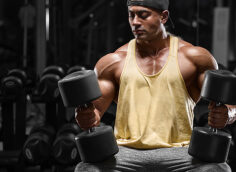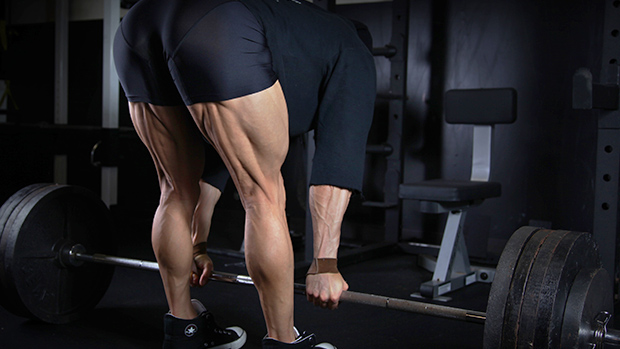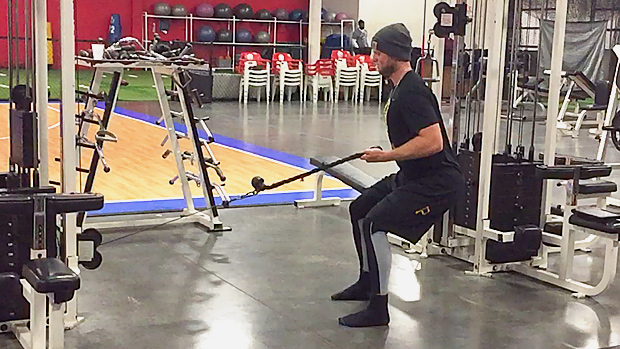I'm sick of writing training articles. No wait, let me rephrase that. I'm sick of writing articles about training routines.
I know that many people need to be spoon-fed and given a precise routine to follow. In some cases, this is actually necessary. For example, beginners who don't know anything about training properly can greatly benefit from using a complete training program. Others might have a specific problem or weakness that requires a precise program.
However, average T-Nation readers are more advanced and open-minded than most regular gym rats. They're more into thinking for themselves; they want to learn the "why" and "how," not merely the "what."
It's with these guys and gals in mind that I'm writing this article. It's a training article, yes, a shoulder training article in fact. But I won't give you a specific routine or tell you which exercises to choose, how many sets and reps to do, or what technique to rely on.
I will, however, give you all the info you need to be able to make those decisions yourself. In the long run, this will be a lot more effective than giving you yet another "ready-to-wear" workout routine!
The elements that'll allow you to design an effective deltoid workout are basically the same ones that apply to the development of every other muscle group:
- Optimal exercise selection
- Proper loading parameters depending on the goal
- Frequency of training
Below I'll show you how to make the proper decisions regarding these elements when trying to design your deltoid workout.
Getting the muscle gains you want and getting them "where" you want them is mostly dependent on proper exercise selection. While it's true that every lifting exercise, when performed with correct form and progressive resistance, will lead to added muscle mass, it's not true that all exercises are created equal. And most importantly, not all exercises are created equal for everybody!
The gains you'll get from an exercise will depend on your leverages, body type, muscle dominance, and other factors. So it's really impossible to tell you exactly what exercise to use in your own program. Rather, I'll give you a list of what I consider to be the best deltoid exercises and will tell you their individual particularities so you'll be able to determine which ones are best suited to you.
We'll divide deltoid exercises into several groups:
- Basic exercises: Generally, these exercises will have the most profound effect on overall muscle mass as well as strength gains. However, they will tend to develop certain parts of the deltoid more than others since the body will use the portion of the muscle better suited to do the job. In most cases, these basic exercises will put more stimulation on the anterior head of the deltoid. The lateral head will come in second and the posterior head will come in last. So while these movements are the best overall mass builders, they're not sufficient to develop complete and healthy shoulders.
- Secondary exercises: These are intermediate exercises – not really big basic movements, but not isolation exercises either. They're very good overall mass builders, but can be used to emphasise certain portions of the deltoid more so than others.
- Auxilary/isolation exercises: These movements are used to put a training stress on a specific portion of a muscle. They should only be used if one specific portion of the shoulder is being understimulated compared to another portion, or if an individual is dominant in one of his deltoid heads (normally the anterior head). Isolation work for the anterior portion of the deltoid is normally not needed since this zone is already being fully stimulated by the basic and secondary exercises. However, isolation movements for the lateral and posterior heads are necessary for most.
- Remedial/pre-hab exercises: These movements are used to prevent or "cure" shoulder injuries. More often than not, we're talking about rotator cuff work.
1. Muscle Clean and Push Press
With this exercise, you simply can't avoid building a lot of deltoid size!
However, it's not for everybody. Even though it's a very simple variation of an Olympic lift, it still requires some learning and coordination. But if you don't have a serious injury and are pretty coordinated, there shouldn't be any problems learning it.
It's a two-part movement. First you "clean" the weight starting from the hang position (bar hanging slightly above the knees) up to the shoulders. In French, a clean is called an épaulé which can be translated to "shouldering" or "bringing to the shoulders."
The difference between a muscle clean and a power clean is kinda like the difference between a push press and a push jerk. In both a push press and a push jerk you use a simultaneous action of both the legs and arms to press the weight overhead. The difference is that in the push press you only use a slight leg drive to get the bar started, but most of the job is being done with the arms.
In a push jerk the role of the legs and arms are reversed: you use a powerful leg drive which does most of the work; the arms are secondary to this strong leg drive.
So while in a power clean you'd use a powerful lower body action to lift the weight to the shoulders, in a muscle clean you use a slight leg action to help get the bar on its way while the arms do most of the work. Here you can see the difference between both movements.


So in the muscle clean and push press you start off by "shouldering" the bar, lifting it from the knees up to the shoulders using a slight leg drive and a strong arm action. Keep the bar close to your body; this isn't a reverse curl!
Once the bar has been lifted to the shoulders, execute the second part of the movement: the push press. Lift the bar from shoulders to overhead using a small leg drive and a strong arm action. Lower the bar back down to your shoulders, then to your knees and start the next rep.
This is the best exercise for adding overall size to your deltoids. It'll also stimulate your traps, so it's a complete "power look" exercise! Obviously, it's anterior deltoid dominant. So even if it's the best overall deltoid movement, it's generally insufficient to fully develop your shoulders. But if you could only perform one deltoid exercises, this one should be it!
2. Push Press
The first portion of the muscle clean and push press can be hard on the shoulder joints of some individuals (kinda like an upright row), so if you can't do it without pain you can simply stick to the second portion of the movement: the push press.

This option is also viable for those who have a very weak "muscle clean." For example, if you can only muscle clean 135 pounds but can push press 205 for 5 reps, you'll be limited in the stimulation you can put on your shoulders if you were to stick to the muscle clean and push press. In that case, it would be much smarter to only perform the push press portion.
3. Barbell Military Press
Let's get one thing straight: you can't perform a seated military press. It's impossible! A soldier doesn't sit at attention, does he?
The term "military" refers to the posture taken during the execution of the exercise: hold yourself like a soldier standing at attention: chest puffed out, heels close together, legs straight, chin tucked in, shoulders back.

So a military press refers to a standing shoulder press performed without any form of cheating or body lean: you keep the military posture at all times during the course of the exercise. This movement is a tremendous shoulder builder and will also strengthen the "core" or trunk muscles, the serratus, as well as the glutes and hip musculature.
4. Seated Barbell Press
Performing the overhead shoulder press seated has some advantages compared to the standing variation... and some disadvantages, too.
Most people will be able to use more weight seated than standing. Using more weight can lead to more growth stimulation placed on your shoulders. On the downside, the seat decreases the involvement of the core, glutes, and hips.
It's also worth noting that performing the movement seated drastically increases lower back stress by increasing spinal compression. When seated, the lower back is "compressed" directly between the weight and the seat. When you stand, the weight is still there but the downward force is partially "absorbed" by the legs and hips, reducing lower back strain.
5. Dumbbell Military Press
This movement is basically a variation of the barbell press. I like dumbbells since they allow for a more natural hand position and more leeway in execution. Dumbbells also require more stabilization at the shoulder joint (which can either be a benefit or a disadvantage).

The main problem with dumbbells is that when you get pretty strong, it can become very hard (and even dangerous) to bring the dumbbells into the starting position since you essentially have to clean them. Bringing heavy dumbbells down at the completion of the set can also put the shoulders and elbows at risk.
6. Seated Dumbbell Press
This is similar in both pros and cons to the seated barbell press with the added characteristics of the standing dumbbell press (shoulder stabilization and more movement control). The problem of bringing the dumbbells to the starting position is less pronounced than with the standing version (and a partner can more easily help you), but it can still be problematic when you reach weights that are above 80 pounds.
Lowering the weight back down at the end of the set is even harder than with the standing version because you can't use your lower body to absorb the shock. The dumbbell variations are very effective, even more so than the barbell variations in some cases, but as an individual gets stronger, using dumbbells sometimes can do more harm than good.
7. Scott Press

This is fairly similar to an Arnold press. Like the Arnold press, start with the dumbbells held in front of you. In the Arnold press you'd simply lift the weights while rotating the dumbbells. In the Scott press, you rotate the weights as you perform an overhead movement that's closer to an exaggerated lateral raise.
This exercise is the "pressing" movement that'll put the most stress on the lateral portion of the deltoid. It even hits the posterior portion somewhat. When properly executed, it's one of my favorite shoulder builders.
8. Single-Arm Standing Dumbbell Press
The good thing about performing the single arm version of the movement is that you can use the free arm to bring the dumbbell into the starting position and then to lower it back down at the end of the set.

There's also some evidence that single limb/unilateral movements can be more effective at recruiting high threshold motor units, which have the greatest growth potential.
Unilateral work will also have an important postural component (since you have to work harder to maintain a proper posture with only one side loaded) and it can be very effective for those who have left/right imbalances – their strong side will tend to take over barbell movements, leaving the weaker side understimulated.
9. Single-Arm Corner Press
I like this exercise for athletes as well as for individuals with mild shoulder problems. (It can be used instead of a dumbbell or shoulder press.) It's also more specific to athletes than regular overhead presses because of the pushing angle, and it places much less strain on the rotator cuff than regular overhead pressing, making it a relatively pain-free movement for those with tender shoulders.

Simply place one end of the bar in a corner and load the weight on the opposite end. Start with the bar a few inches from your shoulders and press in upward and forward at a 45 degree angle. You can also perform this exercise as a push press, bending the knees at around a 135 degree angle to push it with the legs and arm at the same time.
10. Two-Arm Corner Press

This is the same exercise as we just saw but it's performed with both hands on the bar. While very effective, I find this exercise a bit more problematical than the single-arm version because as you get stronger, bringing the bar to the starting position can become challenging, if not dangerous.
However, you can make it easier by resting the plates on a training bench, picking it up in a low squatting position, then standing up to press it.
11. Elbows-Out Barbell Front Raise
When we think of a front raise we think of an isolation movement for the front portion of the deltoid, which is accurate, especially if done with dumbbells with a hammer/thumbs-up grip. However, if done with a barbell, with the elbows turned outward (even trying to turn them toward the ceiling) it actually becomes quite an effective exercise for the whole shoulder. The key points are:
- Lead with the elbows. Imagine that you're lifting the elbows, not the bar.
- Turn your elbows out as much as possible. This will increase the involvement of the lateral head of the deltoid.
- Keep the torso bent forward slightly. This will reduce the contribution of the front portion of the deltoid.
- At the top of the movement, try to squeeze the lateral head of the deltoid by attempting to rotate the elbows even more.
12. Unwinding Press
This exercise is very similar to an old-time strength feat called the iron cross or crucifix, which consisted of holding dumbbells at arms length by the side of your body and parallel to the floor.

We aren't going to be using the holding variation, but we will inspire ourselves with this feat of strength to design a type of dumbbell pressing that'll focus most of the stress on the lateral portion of the shoulders.

We want to perform the unwinding press in such a way that it truly places a lot of training stress on the lateral head of the deltoid. Here's how we're going to perform the movement:
- Start with a dumbbell held in each hand. The 'bells are brought up to the shoulders using a neutral (hammer) grip, meaning that your palms are basically facing your ears.
- Slowly press the weights outward and slightly up (at a 30-45 degree angle) while turning your arms so that the palms will be facing the floor at the end of the movement. At the end of the pressing phase, we want the back end of the dumbbells to be slightly higher than the front end. Hold the position for 1-2 seconds.
- Bring the dumbbells back to the shoulders using the opposite action.
13. Two-Hand Dumbbell Swing
This exercise involves the lower back and hamstrings, not just the shoulders, but it still places a lot of stress on the deltoids.

In that regard, it's much like a push press/push jerk: you can use a lot of lower back and hip action which will take some stimulation off of the deltoids, or you can only use a slight lower back/hips "kick" to get you started. Focus on lifting the weight mostly with the arms which will turn the exercise into a great shoulder builder.
14. Reverse Grip Barbell Press

This version of the exercise allows you to get a longer range of motion without putting the shoulder joint at risk. It can thus be very effective for building the shoulders. However, larger individuals and those less supple might have problems executing this movement.
15. Incline Lateral Raise
What I like about the incline version of the lateral raise is that you absolutely can't cheat. You can also get a better deltoid stretch at the bottom of the movement, which helps with fast-twitch motor unit recruitment.

The downside is that although it's a lateral head dominant exercise, the anterior portion of the deltoid will also be involved quite a bit due to the angle of the trunk. Note that you should make an effort to keep the back end of the dumbbell at least as high as the front end to maximize lateral head recruitment.
16. Seated Lateral Raise

This movement is similar to the incline version, but it doesn't provide a stretch and some cheating is possible (which isn't necessarily bad, if used correctly and at the right time).
However, since the torso is upright instead of leaning back, it's easier to take the anterior portion of the deltoid out of the movement. Still, focus on lifting up the back end of the dumbbell.
17. Lean Away Lateral Raise

I like this exercise a lot. Compared to other free-weight lateral raise variations, it puts the deltoid under tension for a greater proportion of the range of motion, making each rep more effective. Since it's a unilateral movement it facilitates the recruitment of high threshold motor units in individuals with a large strength deficit, in beginners, and in long-limbed individuals.
18. Gironda Dumbbell Swing
This is a rather odd looking exercise, but it's a very effective way to build the whole deltoid with an emphasis on the lateral portion.
Basically, the movement is like performing a one-arm lateral raise while the other arm is brought up with the elbow bent at a 90 degree angle. The bent arm doesn't do much work because of the advantageous lever, but it allows you to keep some tension on the shoulder muscle during the whole exercise. Constant tension equals more growth! The sequence below illustrates what one repetition looks like:

19. Chest-Supported Lateral Raise
Performing lateral raises with the trunk leaning slightly forward while bringing the arms just behind the body line will greatly inhibit the action of the anterior deltoid. As a result, more stress is placed on the lateral portion and some on the posterior head.

You could simply perform a standing lateral raise motion with the torso bent forward at a 30 degree angle, but I prefer to lie down chest-first on a high-incline bench to prevent any form of cheating. Plus, using the bench removes the need to maintain proper posture.
Now, in some cases it's advisable to use an exercise in which you need to contract several muscle groups to maintain a proper lifting posture, but when you're trying to isolate a certain muscle group, doing so takes away from the neural drive to the targeted muscles and as a result it's harder to get a quality isolated action in the desired muscle group.
You should use a pronated grip at the top, meaning that when the lift is completed the palms of your hands are facing straight down.
20. Bent-Over Lateral Raise
This is a classic rear/posterior deltoid exercise that also activates the rhomboids and trapezius muscles.

The "thumbs down" hand position focuses the most tension on the rear deltoid itself. A "palms down" position will have more of an overall effect, targeting the lateral head of the deltoid and the rhomboids more than with other grips. Finally, the "thumbs up" position actually reduces the activation of the rear deltoid, thus putting more stress on the rhomboids and traps.
Note that no isolation exercise for the anterior portion of the deltoid is included in the list. This is because this portion is rarely lagging behind the rest of the shoulders. In fact, most people have an anterior deltoid that's developed out of proportion to everything else. Very few individuals will need direct isolation work for this part of the shoulders.
Loading parameters typically refer to sets, reps, and the load used. When it comes to shoulder development, several different loading schemes can be used. The loading parameters will obviously depend on your goal (strength emphasis, size emphasis, aesthetic emphasis, endurance emphasis, etc.) as well as on the type of exercise being performed.
For example, you'll generally perform fewer reps (with more weight) on the basic exercises than on the secondary exercises. Similarly, the secondary exercises will normally be performed with less reps than the isolation work. More sets are also the norm with more complex movements (basic and secondary).
The following table will give you a nice starting point when planning your workouts:

One parameter that's left to explore is the number of exercises per session. As a rule of thumb, most people should stick to around 9-16 sets per major muscle group. This isn't anything set in stone. Yes, some people can tolerate more volume than that. Yes, some won't be able to recover from 9 good work sets for a muscle group. So take that as a starting point only.
So the number of exercises per session will depend on the number of sets per exercise. If you train for functional hypertrophy (size and strength) and you have 9-16 sets to "spend," you could do:
- 1 basic exercise for 5 sets, 1 secondary exercise for 4 sets, 1 auxiliary exercise for 3 sets (total of 12 work sets)
or
- 1 basic exercise for 4 sets, 2 secondary exercises for 3 sets each, 1 auxiliary exercise for 3 sets (13 total sets)
or
- 2 basic exercises for 4 sets each, 1 secondary exercise for 4 sets (12 total sets)
The shoulders are heavily involved during chest work and sometimes in upper back work too, so they already receive a lot of indirect work. As such, they might not require more than one "real" shoulder workout per week.
The exception would be a spec routine used by someone with really weak shoulders who wishes to focus on developing them. In this case, it's possible to perform two or even three weekly shoulder sessions, but you have to reduce the training volume for your other muscle groups (especially for chest) to avoid overstressing the deltoids.
However, even if you're not using a spec approach, it's possible to train your shoulders two or three times per week by using fragmented training. Fragmented training means that you divide your weekly training volume into several smaller training units.
For example, instead of doing 12 sets of delt work once a week, you can perform 6 sets twice a week or 4 sets three times a week. This is especially effective when training for strength rather than size. This can either be done as part of a whole-body routine performed three times a week, an upper/lower body split (4-6 sessions per week), or simply by adding a small volume of deltoid work at the end of other major workouts.
Advanced techniques such as drop sets, pre-fatigue, post-fatigue, rest/pause, tempo contrast, etc. are very effective for every muscle group, deltoids included. However, these methods are very stressful on both the muscle structures and the CNS (even on the adrenals). Overusing these torture techniques can eventually lead to stagnation or even regression.
The deltoids are especially at risk because of the fragility of the shoulder joint as well as the fact that the deltoids are active in almost every lifting movement there is (not necessarily as active movers, but as fixators and stabilizers). The shoulders are more likely to become overstressed than other muscle groups.
For this reason, it isn't necessary to use a lot of advanced techniques when training deltoids. It's okay to use some from time to time or during a spec phase, but most of the time you should stick to "regular" basic lifting.
You now have all the tools you need to design a great delt program. In fact, this article should allow you to design your own effective deltoid workouts for the next ten years at least! Go to it!





